
It’s doubled survival rates in rat studies
—-Important Message—-
This cheap white powder oxygenates the cells; kills cancer cells
Multiple studies show that cancer cells thrive in low-oxygen states…
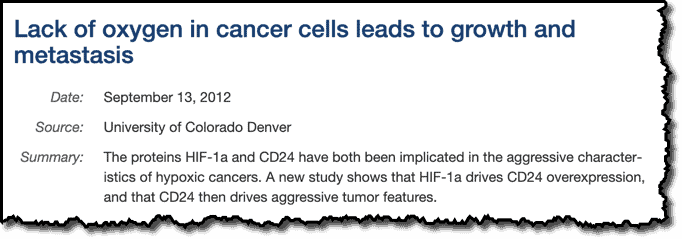
…so cancer cells hate oxygen the way a burglar in the night hates bright lights.
And this natural white powder — it oxygenates the cells according to a mouse study, making cells healthier and more resistant to cancer.
It’s like a spotlight shining directly onto every single one of your cells, protecting them and ready to act if any threat appears…
And you can get a pound of it for 89 cents or less at most grocery stores. You may even have some in your kitchen right now…
Here’s the cheap white powder that oxygenates the cells and may kill cancer cells in men
———-
Does baicalein stop tumor growth in its tracks?
Classic characteristics of cancer cells are low intracellular potassium concentrations, low membrane potentials, low pH, and high proliferation rates.
As consistent as those are, and very important, cancer is also distinguished on a more regional level.
Groups of cancer cells conspire together to sequester more than their fair share of blood flow.
This increased vascularization greatly enhances cancer growth on a multicellular level, promoting the colony’s ability to recruit blood growth factors of all types.
Cancer inhibition can then also be achieved in a more abstract way decreasing its octopus-like vasculature.
Tumor cells shouldn’t be allowed to have more blood, as that would be unfair to normal cells (and potentially fatal).
Nothing is more important for neo-vascularization than Vascular Endothelial Growth Factor (VEGF).
Unlike the misnamed proteins Na+/K+-ATPase, uncoupling protein, and bromodomain, the Vascular Endothelial Growth Factor does EXACTLY as you’d infer from its name.
Also important are Matrix Metalloproteinases.
These are a class of enzymes secreted by cancer cells that break down extracellular collagen, thereby making room for blood vessels and more cancer cells.
‘Angiogenic regulators formed the highest group of altered genes when grouped according to cancer hallmark,’ ―Cathcart
Angiogenic regulators deserve a prime spot on the list of genes critical to cancer growth, no less important than the notorious ornithine decarboxylase, 12-lipoxygenases, stearoyl-CoA desaturase, cyclooxygenase-2, and p53.
Baicalein has been shown to reduce VEGF output in all animals, in all cell lines studied, and in micromolar concentrations.
This attenuates the selfish nature of tumor cells relative to normal cells by decreasing the number of new vessels formed:
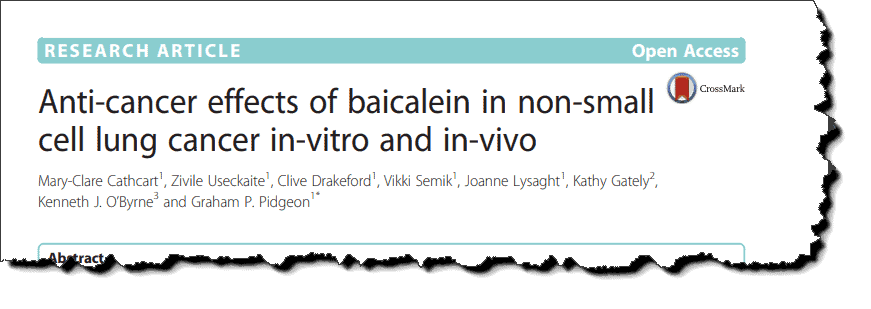
Cancer of the lung(s) is the most fatal cancer type, and actually quite common.
Lung cancer represents 12% of all cancer-related deaths worldwide.
This is certainly because the lungs experience the highest nitric oxide flux of all organs, a consequence of its natural role in gas exchange.
The lungs are exposed to INHALED environmental nitric oxide, and also to EXHALED nitric oxide from endogenous formation (e.g., arginine + iNOS).
‘Baicalein significantly decreased lung cancer proliferation in H-460 cells in a dose dependent manner.’ ―Cathcart
Baicalein is unique among the scores of dietary flavonoids because it inhibits glyoxalase-1 (Zhang, 2006).
This translates into the best cancer fighting ability among the flavonoid class, more often than not.
Its potency rivals synthetic substances, even those explicitly designed and selected-for with potency in mind.
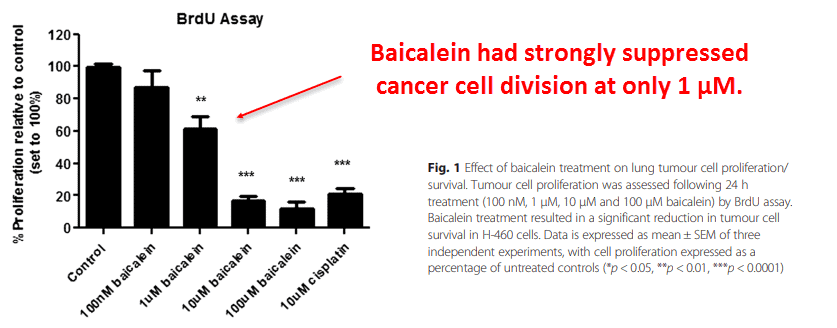
Activity within this range is important with the flavonoids because these are their physiological concentrations.
A moderate feeding of Scutellaria baicalensis extract to mice — for example, at 1% weight per weight food — resulted in a 1.33μM lung concentration, a 1.34μM pancreas concentration, and a 4.60 μM prostate concentration (Qing-Yi Lu, 2002).
Baicalein did better than cisplatin at 10 μM in this study, quite the embarrassment for an overpriced DNA-binding replication inhibitor with a precious metal atom.
And even more importantly, baicalein doesn’t work by indiscriminately targeting DNA replication like cisplatin, methotrexate, and 5-fluorouracil do.
Glyoxalase inhibitors are much more nuanced, and work by inhibiting the transcription factors Sp3 and HIF-1 (hypoxia inducible factor).
If DNA chain terminators represented the “shotgun method,” baicalein would be James Bond’s silenced Walther PPK aimed at angiogenic regulators — illuminated with a laser-dot.
‘A total of eleven genes were significantly altered following baicalein treatment, with gene expression changes across all biological pathways observed.’ ―Cathcart
The greatest changes — SKMES1 cancer cell line — had been in Fibroblast Growth Factor Receptor (−3.29×), Vascular Endothelial Growth Factor (−3.29×), and Matrix Metalloproteinase.
These pro-angiogenic agents are very influential, and they can be downregulated in living mice following modest doses of baicalein:
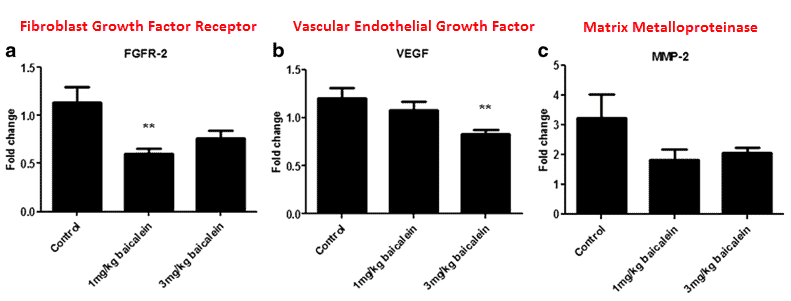
Baicalein also correlated with a decreased immunostaining for these proteins, redundantly proving the decrease for enhanced believability.
Baicalein also greatly increased their survival.
Baicalein had also slowed the cell’s mitotic rate and microvessel formation, just as you’d predict from lower VEGF and FGFR-2.

This is not unusual for baicalein, not at all.
This is an uncommon flavonoid that has consistently doubled survival rates in all cancerous rodents I’ve observed so far.
And it works on human cells too:

In this study: baicalein began to inhibit prostate cancer cell proliferation in the low micromolar range, a concentration easily achievable through oral dosing.
This was an androgen-independent cell line, exemplifying the general antineoplastic effect glyoxalase inhibitors have been historically known for.
Methylglyoxal can certainly modify more than one receptor type, and also many enzymes and transcription factors besides.
‘Expression of both FGFR-2 and VEGF was significantly reduced by baicalein treatment, relative to the control group, validating previous observations in-vivo and in-vitro. MMP-2 and MMP-9 have previously been shown to be negatively affected by baicalein treatment [10, 16].’ ―Cathcart
Increasing intracellular methylglyoxal acts to suppress transcription factors, activate others, and can even modify enzymes directly: e.g., carbonic anhydrase, 12-lipoxygenase, etc.
And although they didn’t measure VEGF changes in this study, they showed a decrease in “sprouting.”
Sprouting is the formation of neo-vessels emanating from cancer cell colonies:
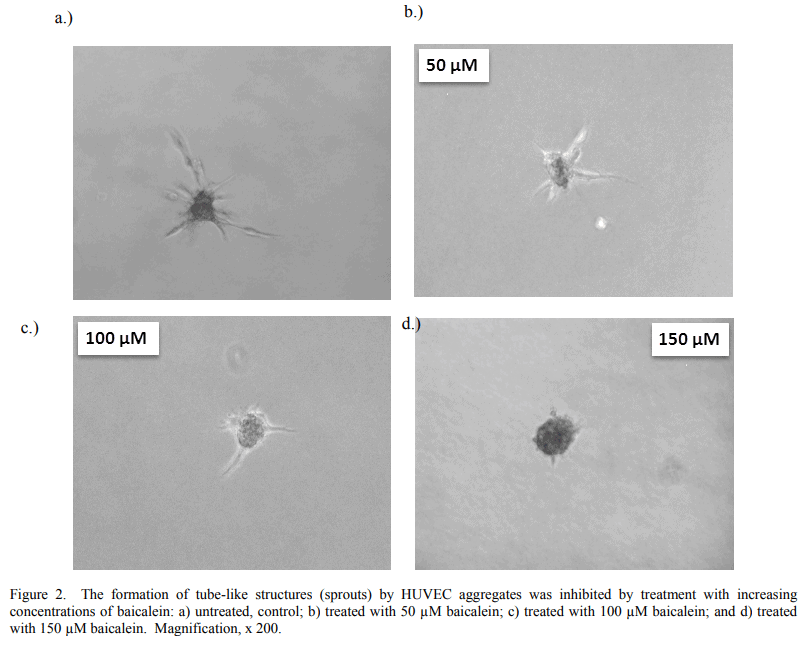
These are consistent effects, and since VEGF and FGFR-2 have both been shown to be downregulated by baicalein before this study even started, more than once, you could have confidently predicted its results beforehand.
The rodent survival arm of the study showed the obligatory lifespan increase gained from enhanced methylglyoxal signalling, executed via baicalein…
…which obviously arose from a delay in cancer angiogenesis and tumor growth:
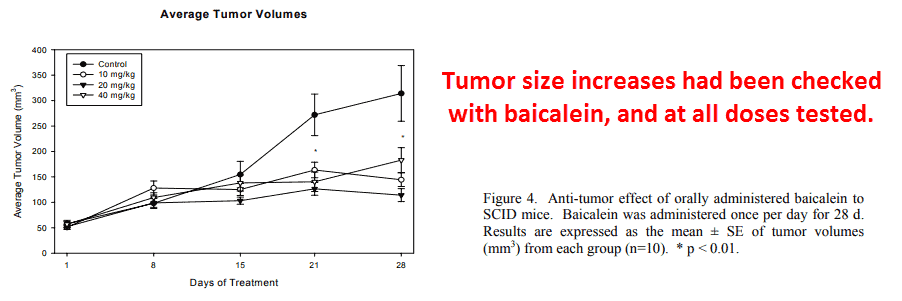
This was despite the iron-enriched, methionine-enriched, and high linoleic acid rodent food — unethical by all standards.
Baicalein can do this because it has consistently been shown the third most potent natural glyoxalase-1 inhibitor, right behind lapachol and β-lapachone.
However: baicalein is commercially available in purified form and lapachol is not, making baicalein more convenient than drinking quarts of pau d’arco tea every day.
‘Histological analysis of resulting tumour xenografts demonstrated reduced expression of both 12-lipoxygenase and VEGF proteins in baicalein-treated tumours, relative to untreated. A significant reduction in both mitotic index and micro-vessel density was observed following baicalein treatment. Gene expression profiling revealed a reduction in both VEGF and FGFR-2 following baicalein treatment,’ ―Cathcart
Vascular endothelial growth factor and its receptor are both under genetic control of Sp3, ER-α, and HIF-1.
Of these three transcription factors, Sp3 is the most important under normal circumstances.
The Sp3 transcription factor was shown to be modified by Sin3A, thereby releasing it from DNA-binding (Yao, 2007).
Sin3A is a methylglyoxal-sensitive transcription modifier, a corepressor using a “hotspot arginine” to respond to cellular methylglyoxal concentrations.

Methylglyoxal is a spontaneous product of glucose metabolism, and it appears to have evolved as a convenient signal to represent it.
Under conditions of low methylglyoxal, more VEGF is produced, and hence more blood vessels are formed.
Cells ostensibly do this because they assume low methylglyoxal means “less glucose,” and therefore create more blood vessels to obtain more.
‘Major stimulators of VEGF expression include hypoxia and hypoglycemia (24), which occur frequently within the expanding tumor mass and particularly in regions surrounding necrotic areas within diverse types of tumors (24).’ ―Qian Shi
A very similar induction of VEGF happens under hypoxia, or the cell’s lack of oxygen.
A transcription factor named Hypoxia Inducible Factor (HIF-1) senses low oxygen using H2O2 as a signal, and strongly induces VEGF in response.
Methylglyoxal actually inhibits the VEGF increase caused by hypoxia and free iron, and does so by modifying p300 — the binding partner of HIF-1 (Thangarajah, 2009).
The modification of p300 also occurs with the classic arginine ⟶ hydroimidazolone transition.

These are the very same changes observed with baicalein, a flavone that’s been known to inhibit glyoxalase-1 since 1986 (Lio, 1986).
Glyoxylase-1 transforms methylglyoxal into lactic acid using a glutathione cofactor.
Overexpression of glyoxalase-1 enzyme is seen in many cancers (Wang, 2002), if not most, and this causes a reduction in cellular methylglyoxal concentrations.
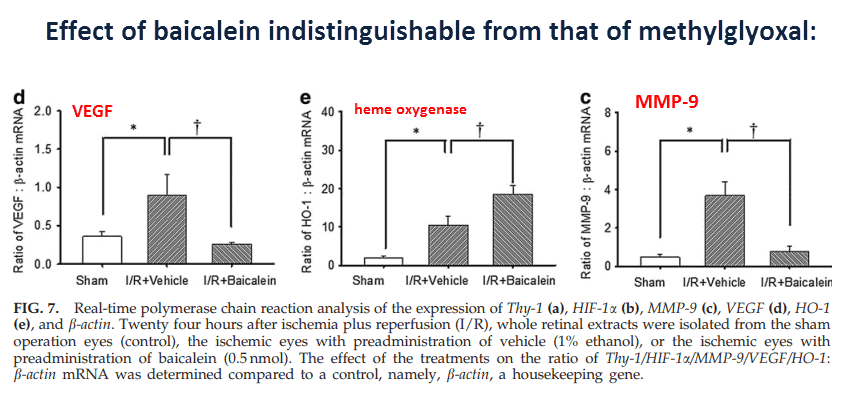
The cell always perceives low methylglyoxal as “low glucose,” whether real or only apparent.
It should be of no surprise to anybody that angiogenesis is under the control of oxygen tension and methylglyoxal, our evolutionary sensor for glucose that was selected-for on account of reactivity
Glucose and O2 are the two most important things for cell survival, and they both derive from the circulation…
‘This significant MMP-9 mRNA upregulation was significantly attenuated by pretreated baicalein; however, the strong antioxidant trolox only attenuated the MMP-9 mRNA upregulation to an obviously lesser degree than baicalein. […] Thus, the underlying mechanism of the inhibitory effect of baicalein on retinal ischemia-induced MMP-9 upregulation appears to be only ‘‘partially’’ related to its anti-oxidative effect.’ ―Chao
—-Important Message—-
This penile-oxygen trick pumps up the male member like a balloon

I’ve discovered that all men need is more oxygen for bigger, better boners.
Because when the member gets more oxygen, the inner tissue matrix expands, making things more engorged…
And more oxygen means more blood flow!
More hot, pumping blood flowing into the penis, making it thick and full, even when flaccid.
So the answer is more oxygen — but how to get it?
Here’s the simple 7 minute oxygenation method that pumps up the male member like a balloon
———-
